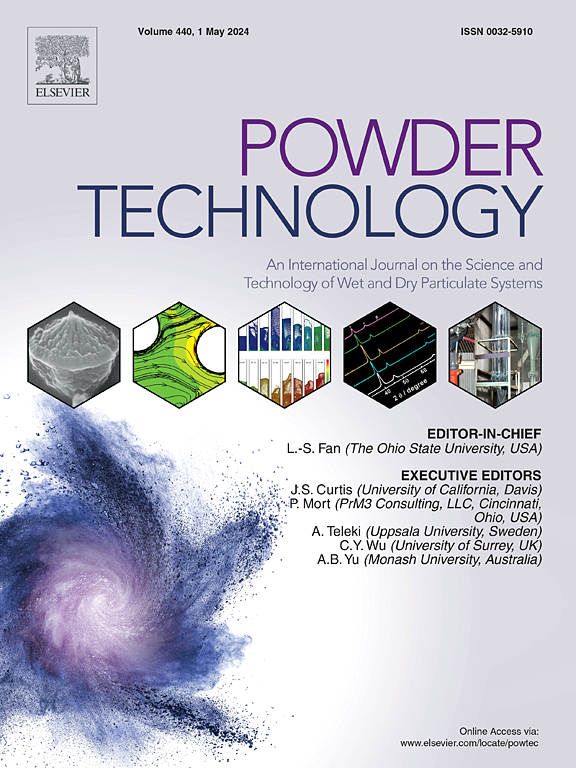Regulatory mechanism and applicability of pulsed gas on drying uniformity of non-spherical wet grains in a fluidized-bed
IF 4.5
2区 工程技术
Q2 ENGINEERING, CHEMICAL
引用次数: 0
Abstract
Pulsed gas can regulate the uniform fluidization of particles, thereby enhancing the product quality of wet grains after drying. However, due to the diversity of grain shapes, the regulatory mechanism and applicability of pulsed gas on the drying uniformity of grains remain unclear. This study used an improved CFD-DEM drying model for wet grains to investigate how particle shape and pulsed frequency affect flow, heat transfer, and mass transfer. The results showed that increasing pulsed frequency can change the particle mixing mechanism from convective to diffusive, and reduce the particle residence time in high-temperature regions. The formation frequency of horizontal channel-like bubbles influences the mesoscale structure evolution and interphase heat transfer uniformity. However, higher pulsed frequency decreases contact time between particles and bubbles, requiring a balance between mixing intensity and bubble contact. Finally, the intercriteria correlation method quantified the applicability of pulsed frequency for drying particles with different shapes.

脉冲气体对流化床非球形湿颗粒干燥均匀性的调节机理及适用性
脉冲气体可以调节颗粒的均匀流化,从而提高干燥后湿颗粒的产品质量。然而,由于颗粒形状的多样性,脉冲气体对颗粒干燥均匀性的调节机制和适用性尚不清楚。本研究采用改进的CFD-DEM湿颗粒干燥模型,研究颗粒形状和脉冲频率对流动、传热和传质的影响。结果表明,提高脉冲频率可以使颗粒的混合机制由对流转变为扩散,减少颗粒在高温区域的停留时间。水平通道状气泡的形成频率影响中尺度结构演化和相间换热均匀性。然而,较高的脉冲频率减少了颗粒和气泡之间的接触时间,需要在混合强度和气泡接触之间取得平衡。最后,采用准则间关联法量化了脉冲频率对不同形状颗粒干燥的适用性。
本文章由计算机程序翻译,如有差异,请以英文原文为准。
求助全文
约1分钟内获得全文
求助全文
来源期刊

Powder Technology
工程技术-工程:化工
CiteScore
9.90
自引率
15.40%
发文量
1047
审稿时长
46 days
期刊介绍:
Powder Technology is an International Journal on the Science and Technology of Wet and Dry Particulate Systems. Powder Technology publishes papers on all aspects of the formation of particles and their characterisation and on the study of systems containing particulate solids. No limitation is imposed on the size of the particles, which may range from nanometre scale, as in pigments or aerosols, to that of mined or quarried materials. The following list of topics is not intended to be comprehensive, but rather to indicate typical subjects which fall within the scope of the journal's interests:
Formation and synthesis of particles by precipitation and other methods.
Modification of particles by agglomeration, coating, comminution and attrition.
Characterisation of the size, shape, surface area, pore structure and strength of particles and agglomerates (including the origins and effects of inter particle forces).
Packing, failure, flow and permeability of assemblies of particles.
Particle-particle interactions and suspension rheology.
Handling and processing operations such as slurry flow, fluidization, pneumatic conveying.
Interactions between particles and their environment, including delivery of particulate products to the body.
Applications of particle technology in production of pharmaceuticals, chemicals, foods, pigments, structural, and functional materials and in environmental and energy related matters.
For materials-oriented contributions we are looking for articles revealing the effect of particle/powder characteristics (size, morphology and composition, in that order) on material performance or functionality and, ideally, comparison to any industrial standard.
 求助内容:
求助内容: 应助结果提醒方式:
应助结果提醒方式:


